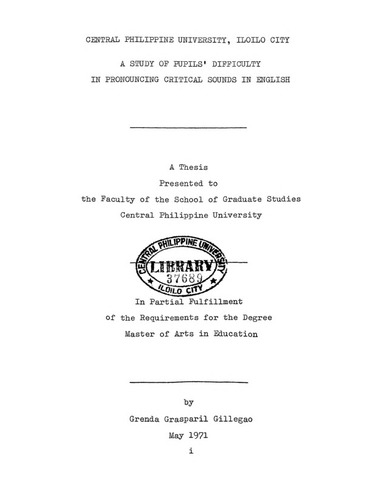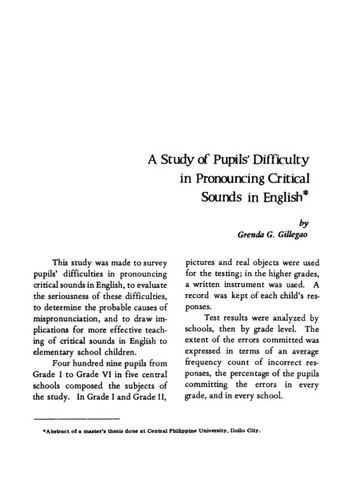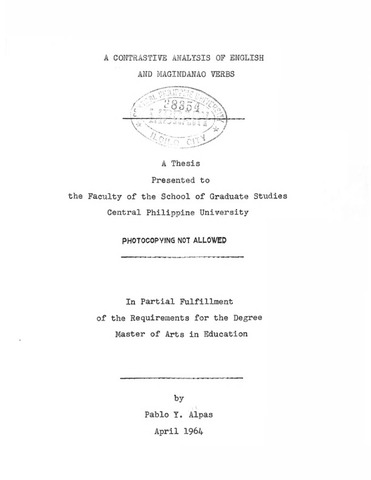Показать сокращенную информацию
Comparative study of Hokkien and English sound systems for the preparation of teaching materials for second language instruction
| dc.contributor.adviser | Griño, Eliza U. | |
| dc.contributor.author | Santos, Carmen P. | |
| dc.date.accessioned | 2021-12-01T05:34:54Z | |
| dc.date.available | 2021-12-01T05:34:54Z | |
| dc.date.issued | 1970 | |
| dc.identifier.citation | Santos, C. P. (1970). Comparative study of Hokkien and English sound systems for the preparation of teaching materials for second language instruction (Unpublished Master’s thesis). Central Philippine University, Jaro, Iloilo City. | en_US |
| dc.identifier.uri | https://hdl.handle.net/20.500.12852/1731 | |
| dc.description | Abstract only | en_US |
| dc.description.abstract | Within the last century or so there has been a growing interest in the scientific study of language. As interest in language increases, linguistic science also advances and new approaches in language instruction are developed. Among these the method most popularly used is the so-called second language instruction. This new approach of language instruction shifts the focus of first attention from methods and techniques of teaching to the basis upon which to build instructional materials. Before dealing with the question of how to teach a foreign language, important preliminary work of finding the special problems arising out of learning a new language habit against a background of a different native language should be done first. The results of such comparisons have proved of fundamental value for the preparation and evaluation of teaching materials and diagnosing student difficulties accurately. As the second language approach gained wide acceptance, Chinese school administrators gradually adopted the new method of language instruction. However, they are confronted with the lack of teaching materials which will adequately meet the needs of a Hokkien speaker learning English. In order to teach English to a Hokkien speaker effectively, there is a need for a comparative analysis of these two languages. The present study is undertaken to meet this need. This study involves three steps; namely, the identification and description of the Hokkien sound system, the comparison of the Hokkien and English sound systems, and a description of the problems of a Hokkien speaker learning English. The first part of the study includes the identification and description of the Hokkien segmental phonemes, the phonetic features of the phonemes, their variants and their distributions. It also includes a description of diphthongs, the accentual system, syllable structure, juncture, and intonation. In gathering the data for this study, the researcher used an informant who is a native speaker of Hokkien. In the identification of Hokkien segmental phonemes, minimal pairs were used. The investigator asked the informant to give the names of familiar concrete objects. Each item was transcribed in phonetic details. The same items were asked several times until their transcriptions were established. This whole process was continued until enough data were collected to allow the formulation of relatively definitive statement about the language. After the identification of Hokkien "vowels" and "consonants", those that were phonetically similar or noncontrastive were examined as to pattern of distribution. These consist of three steps: (a) finding suspicious pairs, (b) framing a hypothesis, and (c) testing the hypothesis. Sounds that showed complementary distribution were consid ered allophones; and those that did not, were considered phonemes. After the identification and description of the Hokkien phonemes, they were examined as to pattern of distribution, syllable structure, and juncture. In the identification of the basic intonation pattern of Hokkien, short conversations were recorded without the speakers’ knowledge so as to insure naturalness of utterance. Then the recorded conversations were replayed several times in order to discover common basic intonation patterns. The utterances were then divided into groups such as statements, request or commands, questions and greetings or leavetakings. The intonation pattern for each group was then examined and identified. In the second part of the study, the comparison of Hokkien and English sound systems was attempted. The comparison was followed by a description of the probable problems that a Hokkien speaker will encounter in learning English as a second language based on the findings of the study. Findings The study reveals the following expected problems of a Hokkien speaker in learning English as a second language: 1. English and Hokkien have different vowel and consonant systems. Whereas Hokkien has only five simple vowels and nineteen consonants, English has eleven simple vowels and twenty-four consonants. Both systems differ in their phonetic features, variant, distributions, and syllable-formation. The Hokkien speaker is likely to find difficulties in articulating English segmental phonemes not found in his native speech. He should also learn new phonemic contrasts, distributions as well as syllable formations. 2. English and Hokkien also differ in their accentual systems. English has an accentual system of the stress type while Hokkien has an accentual system of the tone type. In English, syllables that are identical in vowels and consonants are kept apart by their contrastive stress levels while in Hokkien, they are kept apart by their contrastive pitches or tones. The Hokkien speaker is likely to have a problem in the distribution of the different stresses in English. Hokkien syllables consist of simple onsets and simple codas. In English, onsets and codas may vary from one to three or four consonant and semiconsonant clusters. 3. Both systems have internal open juncture and interludes but the Hokkien interludes are fairly simple being limited to nasal consonants. On the other hand, almost all consonants are used as interludes in English and may vary in number from one cluster to three or four. A Hokkien speaker is likely to have difficulty in recognizing word units in actual utterance because of the variety in the structure and length of English words and the shifting word boundaries. He may have problem also in the location of the internal open juncture and interludes. 4. Hokkien intonation patterns have three pitch levels /1, 2, 3/ and two clause terminals, while English intonation patterns consist of four pitch levels /1, 2, 3, 4/ and three clause terminals. Both differ in the distribution of the pitch levels in their intonation patterns. The Hokkien learner may have difficulty with the pitch level not found in his native speech as well as in the distribution of the different pitch levels in English. | en_US |
| dc.format.extent | 133 leaves | en_US |
| dc.language.iso | en | en_US |
| dc.subject.ddc | GSL Theses 378.242 Sa596 | en_US |
| dc.subject.lcsh | Hokkien dialects | en_US |
| dc.subject.lcsh | English language--Study and teaching (Elementary) | en_US |
| dc.subject.lcsh | English language--Study and teaching--Foreign speakers | en_US |
| dc.subject.lcsh | Teaching--Aids and devices | en_US |
| dc.subject.lcsh | Phonetics | en_US |
| dc.subject.lcsh | English language--Phonology | en_US |
| dc.subject.lcsh | English language--Phonology, Comparative | en_US |
| dc.subject.lcsh | Hokkien dialects--Phonology | en_US |
| dc.subject.lcsh | Hokkien dialects--Phonology, Comparative | en_US |
| dc.title | Comparative study of Hokkien and English sound systems for the preparation of teaching materials for second language instruction | en_US |
| dc.type | Thesis | en_US |
| dc.description.bibliographicalreferences | Includes bibliographical references | en_US |
| dc.contributor.chair | Herradura, Elma S. | |
| dc.contributor.committeemember | Ruiz, Macario B. | |
| dc.contributor.department | School of Graduate Studies | en_US |
| dc.description.degree | Master of Arts in Education | en_US |





